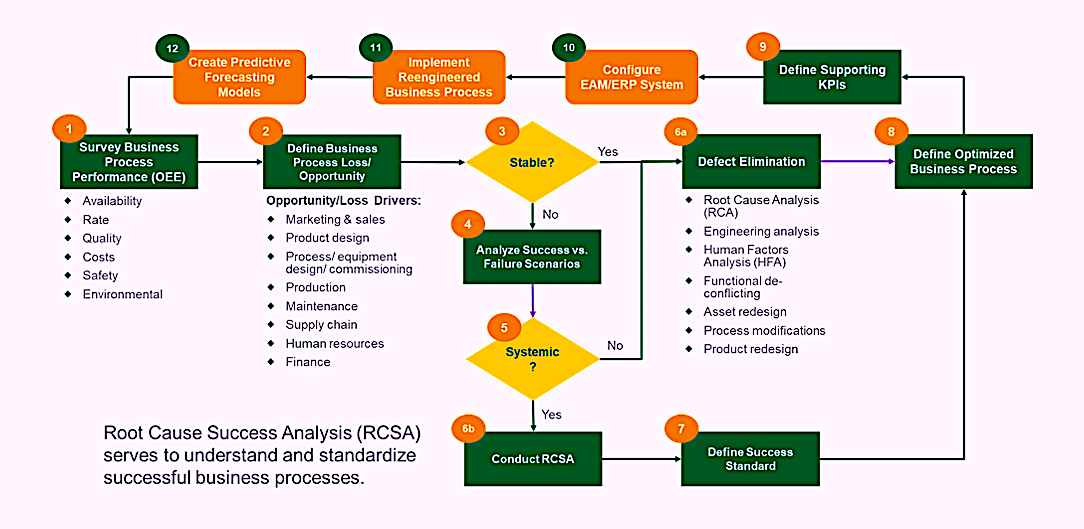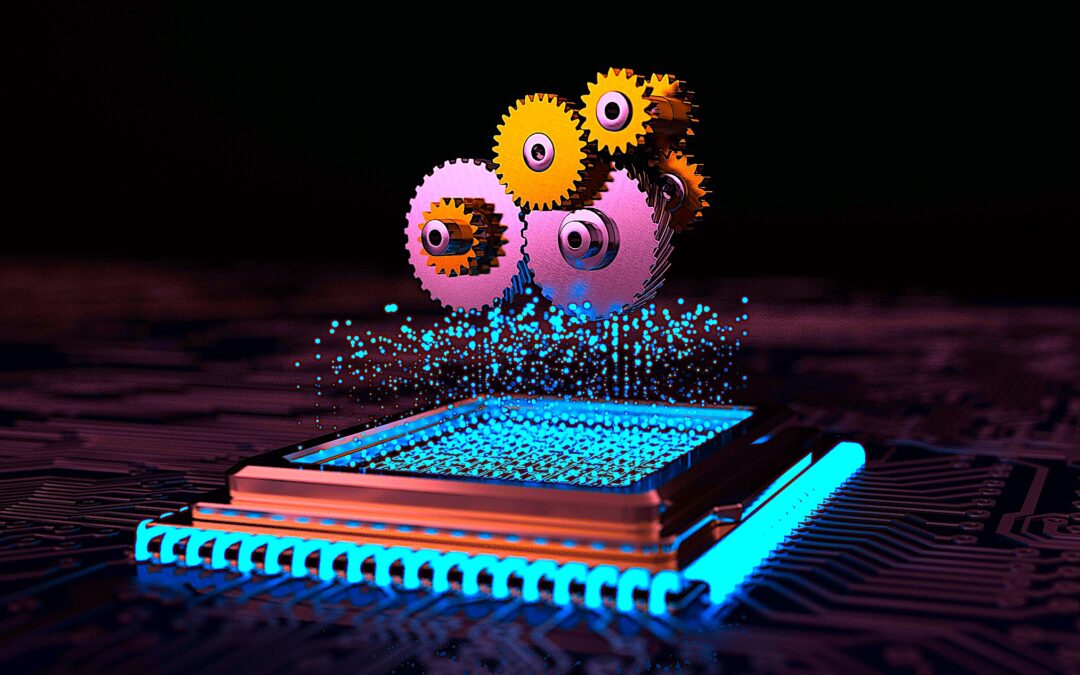Part 1 of this article (April 10, 2022) addressed strategic aspects in the configuring of Enterprise Asset Management (EAM) or Enterprise Resource Planning (ERP) systems for equipment-asset-intensive operations in the manufacturing, process, mining and metals industries. In Part 2 (May 2, 2022), we focused on using Overall Equipment Effectiveness (OEE) to analyze losses and reconfigure business processes to prepare for an EAM/ERP configuration as a part of a 12-step process. (See the links to both articles below.) However, we stopped at Step 9, the creation of KPIs to support effective decisions (Fig.1).
Here, in Part 3, we’ll pick-up with Step 10: configuration of an EAM/ERP in an Industry 4.0 world. Before proceeding with your EAM/ERP as a conversion, a “lift and shift,” or a new, “clean core” installation ask yourself the following questions:
1) Is your current EAM/ERP really serving your decision-support requirements? 2) Are you expecting Industry 4.0 to increase the requirement for clean data that can be readily converted into actionable information?
If your answer to question 1 is “NO” and the your answer to question 2 is “YES,” a simple “lift and shift” conversion is probably not for you. Instead, you’ll want to carefully consider a new business-process-focused “clean core” installation that takes into account information demands for Industry 4.0 and beyond.
Click The Following Links For The Previous Parts Of This Article
 Fig. 1. A 12-step process for Business Process-Centered EAM/ERP configuration.
Fig. 1. A 12-step process for Business Process-Centered EAM/ERP configuration.
INDUSTRY 4.0: A WHOLE NEW BALLGAME
Industry 4.0 represents a dramatic, fast-moving shift in the way we manufacture things. Over time, this shift is likely to give way to Industry 5.0, Industry 6.0… Industry X.0.
From a historical perspective, Industry 1.0 was the original Industrial Revolution that began in the middle of the 18th century. It marked a transition from simple hand tools to production practices with external power sources, such as hydraulic power from water and steam. (Note: The noria, an ancient undershot-water-lifting device dating back to 4th-century Egypt, was powered by water current flow. Used as a pump for crop irrigation, the noria is widely believed to be mankind’s first machine.)
Industry 2.0, which began in the mid- to -late 19the century, introduced railways and wired communication that connected people and enabled integrated logistical support (ILS). Henry Ford, of course, introduced standardization during the Industry-2.0 era. Industry 3.0 began after World War II (in the late 1940s) and introduced early floating-point numbers, incorporation of Boolean logic, and early programmable logic control (PLC) resulting from the advent and advancement of microprocessor-based computers.
Industry 4.0 officially began in 2011. The underpinnings of this transformation started earlier, as sensor technology became better and less expensive and the cost of data transfer, storage, and analysis decreased. Many buzz words and terms are bantered about in relation to the decision support and automation tools associated with Industry 4.0. These include, but are not limited to, the following:
♦ Industrial Internet of Things (IIoT) is a level of connectivity whereby machines solve problems for themselves, without human intervention.
♦ Big Data, as the term implies, refers to the processing, gathering, and storing of large amounts of data for analysis.
♦ Blockchain is used to securely record data in a common ledger and distribute to the points where it’s needed to support a human decision or automate a machine action. Blockchain can secure data and ensure that there is a single version of truth, with respect to that observation.
♦ Machine Learning (ML) is based on the collection of large amounts of data, from which machines can learn, either on their own or assisted by humans. Deep Learning (DL) is an extension of ML.
♦ Artificial Intelligence (AI) is an extension of ML. It enables machines to analyze and solve complex problems in much the same way as humans do, but often much faster.
♦ Augmented Reality (AR) is an overlay of digital information over something that currently exists. It can be great tool for envisioning a 3D future state in design of equipment and production areas.
♦ Digital Twin is a general term for a digital representation of something that is physical, such as a machine, a production line, or a plant.
INFORMATION, NOT DATA: THE DIFFERENCE BETWEEN DECIDING AND GUESSING
It should be clear that data plays a heavy role in Industry 4.0. This role will become even more important as we usher in Industry 5.0, Industry 6.0… Industry X.0. Many years ago, I trademarked the slogan “Data is the Difference Between Deciding and Guessing.” I still believe it to be true, with one caveat: Data must be converted to information to support effective decisions in a plant.
Many organizations are data rich, but information poor. Their data are often incomplete, not effectively organized, or too inaccessible to support effective decision-making. This leaves managers and leaders guessing to fill in the gaps. Humans are relatively good at intuitive decision making, but there are definitely some traps (see my article, “The Human Factors of Failure,” in the link below). In computer science-speak, these intuitions are called “fuzzy logic.”
Fuzzy logic is decision-making based on “degrees of truth” regarding observations and/or interactions between numerous observations. It differs from the more binary “if-then” logic of a Boolean decision tree. Fuzzy decision-making carries an inherently higher risk due to the uncertainty associated with extreme degrees of variability, weak correlations and covariation, and poor logic linking causes and effects.
Click Here To Read The Article
“The Human Factors Of Failure”
Why is this important in your decision to go to the effort and expense to execute a business process-driven, clean-core new EAM/ERP installation as opposed to an IT-driven lift and shift conversion? It’s simple: If key decision-makers currently struggle due to missing, incomplete, disorganized, or inaccurate data under your current EAM/ERP version, how will their decisions improve if the same exact data are available, but in a shiny new GUI screen? The answer is they won’t.
Moreover, if your organization is hotly pursuing the benefits offered by the very data-intensity- and data-quality-dependent tools associated with Industry 4.0, you’re going to struggle. The organization may already be straining to deliver on the promises of Industry 4.0. If so, chances are good the problem comes down to data quality and data organization.
Computers suffer from the same challenges in making decisions when data quality is poor. They’re left to fuzzy logic-based conclusions, which can be flawed for the same reasons that human decisions are. On the plus-side, though, computers aren’t susceptible to biases, incorrect heuristics, and other human factors. But on the flip side, they lack (at least for for now) the benefits of human intuition.
BOTTOM LINE
Here, we’ve built upon the first two parts of this article that made the case for a business process-focused configuration of your Enterprise Asset Management or Enterprise Resource Planning software platform instead of the traditional IT-driven approach. The approach I suggest requires a new “clean core” installation, rather than a simple “lift and shift” conversion. Doing that will take more time, be more complex, and typically cost more money in the short term. However, if you hope to harness Machine Learning (ML), Artificial Intelligence (AI), the Industrial Internet of Things (IIoT), and other benefits of Industry 4.0, Industry 5.0, Industry 6.0, and beyond, you’ll need good data.
Remember: If the humans in your organization are currently struggling to extract information from your existing EAM/ERP system to make effective decisions, Industry 4.0 technologies will also struggle. If that’s the situation in your operations, the answer is clear: You need a new clean-core installation to achieve your business goals. More on that topic later.TRR
ABOUT THE AUTHOR
Drew Troyer has over 30 years of experience in the RAM arena. Currently a Principal with T.A. Cook Consultants, a Part of Accenture, he was a Co-founder and former CEO of Noria Corporation. A trusted advisor to a global blue chip client base, this industry veteran has authored or co-authored more than 300 books, chapters, course books, articles, and technical papers and is popular keynote and technical speaker at conferences around the world. Drew is a Certified Reliability Engineer (CRE), Certified Maintenance & Reliability Professional (CMRP), holds B.S. and M.B.A. degrees. Drew, who also earned a Master’s degree in Environmental Sustainability from Harvard University, is very passionate about sustainable manufacturing. Contact him at 512-800-6031, or email dtroyer@theramreview.com. The opinions expressed in Drew’s articles are his own, not those of his employer.
Tags: reliability, availability, maintenance, RAM, key performance Indicators, KPIs, Enterprise Asset Management, EAM, Enterprise Resource Planning, ERP, Management Information System, MIS, Computerized Maintenance Management System, CMMS, Overall Equipment Effectiveness, OEE



